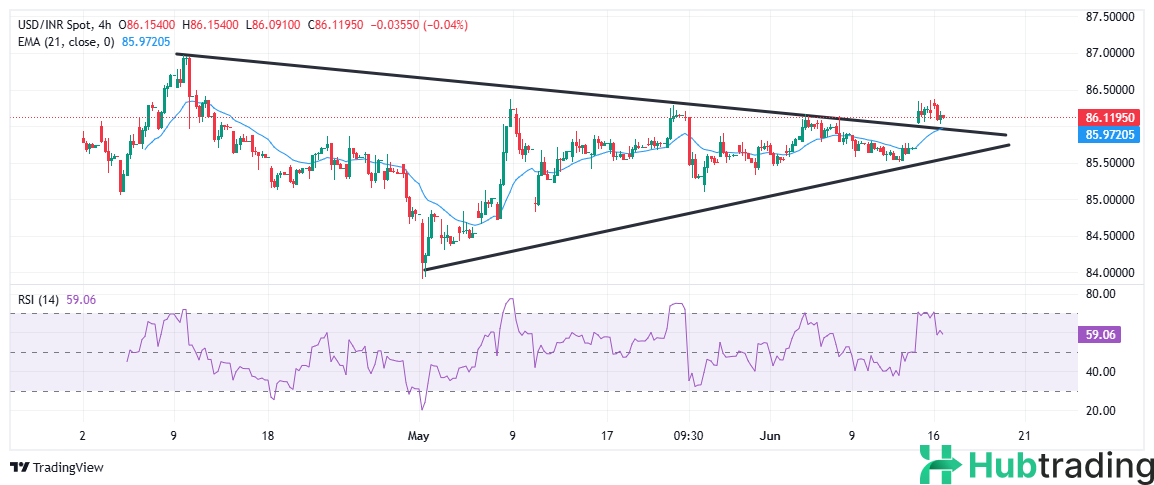-
The Indian Rupee rebounds after two days of declines, supported by a softer US Dollar Index.
-
Improved trade data and cooling wholesale inflation boost market confidence in the INR.
-
India’s benchmark indices, Nifty 50 and Sensex, post a strong recovery.
-
Anticipated RBI intervention helps stabilize the Rupee amid ongoing Middle East tensions.
The Indian Rupee (INR) strengthened against the US Dollar (USD) on Monday, snapping a two-day losing streak as the US Dollar Index (DXY) edged lower and upbeat trade data lifted market sentiment. A narrower trade deficit provided support for the Rupee, which gained alongside a softer Greenback and stable global risk appetite.
The USD/INR pair extended its intraday decline, trading near 86.07 ahead of the U.S. session—down about 0.25% from the day’s high of 86.36. Contributing to the Rupee’s recovery were improved domestic trade figures, easing global crude oil prices after Friday’s rally, and waning demand for the Dollar.
Although the ongoing Israel-Iran conflict has had limited direct impact on India thus far, policymakers remain alert due to the region's critical role in India’s energy supply. New Delhi has maintained a neutral diplomatic position, calling for de-escalation while actively monitoring crude supply chains to safeguard energy reserves.
This cautious yet proactive stance, supported by the Reserve Bank of India’s (RBI) readiness to intervene and limit excessive currency volatility, has helped shield the Rupee from sharp swings. However, any sudden escalation in Middle East tensions could drive oil prices higher and reignite inflationary pressures in India.
Market Movers: Rupee Holds Steady on Strong Data; Fed Decision and Middle East Tensions in Focus
- The Indian Rupee remained stable on Monday, underpinned by steady trade flows and cooling wholesale inflation, even as global traders remained cautious amid rising geopolitical tensions and ahead of the US Federal Reserve’s midweek policy decision.
- India’s trade deficit stood at $21.88 billion in May 2025, slightly narrower than the $23.8 billion recorded a year earlier, indicating resilience in trade performance despite regional volatility. Imports fell by 1.7% to $60.61 billion, aided by lower energy costs, while exports dipped 2.2% to $38.73 billion. Notably, exports to the United States rose to $17.25 billion, up from $14.17 billion a year earlier, suggesting that recent US tariff actions have had minimal direct impact on Indian trade.
- Meanwhile, wholesale price inflation eased to 0.39% in May—its lowest level since March 2024—falling below market forecasts of 0.80%. The decline was driven by a sharp drop in food prices, particularly vegetables, while manufacturing inflation also moderated. Additionally, energy-related costs continued to decline, with lower petrol and diesel prices contributing to overall disinflation. On a monthly basis, wholesale prices slipped 0.06%, marking a second consecutive month of mild declines.
- The Reserve Bank of India (RBI) continues to provide a backstop against sharp currency swings, signaling a readiness to intervene in the FX market if needed—helping to maintain stability in the Rupee even as global risks mount.
- India's equity markets also showed renewed strength. The NSE Nifty 50 surged 227.90 points (0.92%) to 24,946.50, while the BSE Sensex gained 677.55 points (0.84%) to close at 81,796.15, snapping a two-day losing streak.
- On the global front, safe-haven demand supported the US Dollar, fueled by escalating tensions between Israel and Iran, particularly over concerns of potential disruptions to oil transit through the Strait of Hormuz. While oil prices edged higher on geopolitical risk, the Dollar’s strength was capped by mixed sentiment around US trade policy and cautious anticipation of central bank actions.
- In the US, May’s Consumer Price Index (CPI) rose by 0.1% month-on-month and 2.4% year-on-year, slightly softer than expected. The data suggests subdued underlying inflation pressure, reinforcing expectations that the Federal Reserve will maintain current interest rates at its upcoming meeting rather than move toward immediate easing.
- Traders are now closely watching the Federal Open Market Committee (FOMC) meeting scheduled for midweek. While no rate change is expected, market participants will scrutinize the Fed’s updated economic projections and comments from Chair Jerome Powell for clues on the timing of potential rate cuts later this year.
Technical Analysis: USD/INR Struggles to Maintain Breakout Momentum
The USD/INR pair recently broke above a multi-week symmetrical triangle on the 4-hour chart, signaling a possible shift in short-term trend. However, the bullish breakout has lost traction near the 86.50 mark, with the pair now trading around 86.07, just above the 21-period Exponential Moving Average (EMA) at 85.97.
Momentum remains mildly bullish, supported by the 14-period Relative Strength Index (RSI) hovering around 59, indicating upward bias but not yet in overbought territory. A decisive push above the recent high near 86.50 would confirm renewed upside potential, with the next psychological target at 87.00.
On the downside, a break below the EMA and a return to the previous triangle’s upper boundary—now acting as support near 85.90–85.80—could attract renewed selling pressure. In such a scenario, the pair may fall toward the lower ascending trendline support around 85.50, reintroducing short-term bearish risks.






